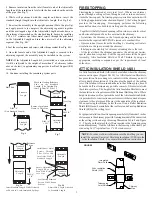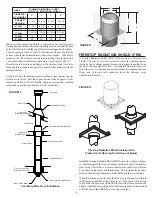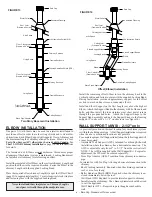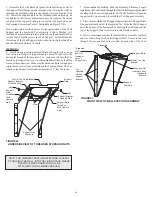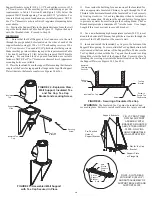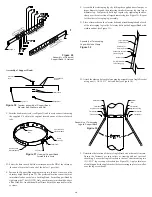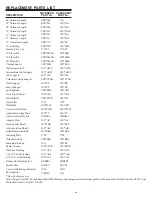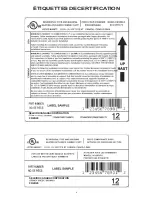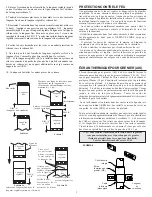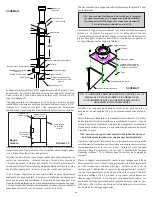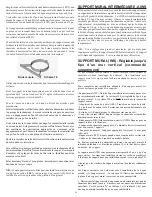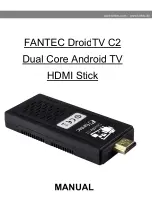
21
“Creosote and Soot - Formation and Need for
Removal”
MAINTENANCE AND CLEANING OF CHIMNEY:
WARNING:
DO NOT USE FUEL MATERIALS CORROSIVE TO
THE CHIMNEY LINER SUCH AS DRIFTWOOD,
PLASTICS, CHEMICALLY TREATED WOOD, ETC.
If chemical cleaner is used to assist in the cleaning of your SuperVent/
SuperPro chimney, make sure it is a product which is non corrosive.
It does not replace the need for a mechanical cleaning. The optimal
method for cleaning a chimney is by a mechanical brushing of the
chimney in conjunction with a complete evaluation of the system by
a certified chimney sweep.
CHIMNEY FIRES AND WHAT TO DO ABOUT THEM
Your SuperVent/SuperPro is not intended or designed for use as a
combustion or fire chamber. It is very easy to overfire your
woodburning appliance with kindling, scrap lumber, brush or any
fast burning fuel. This can produce flames and high temperatures all
the way up the chimney, and may cause chimney damage. The
following materials should not be burned in your woodburning
appliance: pressure treated lumber, rail road ties, salt water driftwood
or plastic. Burning such materials may lead to severe corrosion of the
appliance and the chimney system.
If you see your appliance or the stove pipe glowing red, you are
risking chimney damage, or a fire. The creosote may be burning inside
the chimney. If you see flames coming out the top, you are either
overfiring or there is a chimney fire.
If the fire in your appliance has gotten out of control, or if you suspect
a chimney fire for any reason, follow these steps:
1. Immediately close all dampers and/or air entrance openings to your
appliance. This includes doors on Franklin type stoves. Block off
fireplace openings.
2. Alert your family to the possible danger.
3. Inspect your appliance and chimney surroundings for possible
fire. If in doubt, alert your Fire Department.
4. Do not continue to use your appliance until it and your chimney
have been thoroughly inspected. Overheating can cause metal parts
to expand, buckle and crack. If you are not certain, have a certified
wood technician or certified chimney sweep disassemble all parts so
they can be inspected and replaced.
5. Do not use salt or water on the fire in your appliance. Salt is
corrosive and water will cause a dangerous steam explosion. You
might be able to control the fire by using ashes, sand or baking soda.
Baking soda is an ingredient used for dry chemical fire extinguishers.
6. After a chimney fire, when it is safe to do so, check internal
locations such as the attic and under the roof and keep watching for
two or three hours. There may be delayed smoldering and subsequent
ignition, even if the fire inside the chimney has been controlled.
Chimney and flue pipe are particularly susceptible to off-season
condensation. The incomplete combustion of wood produces acids
which, when combined with moisture, are corrosive. During the
heating season, corrosion tends not to occur because the heat in the
system evaporates the condensation of any water vapour that may
be formed.
Warm, moist air during the summer months passes slowly through
the heating system. It makes any remaining ash or creosote moist
and soggy. Corrosion of steel occurs where these deposits remain.
Off-season corrosion can be reduced considerably if the system is
thoroughly cleaned after the last fire of the heating season. Where
coal is burned, the system must be thoroughly cleaned within 48
hours of shutting down the system for the season and all soot be
removed from the chimney system. This should be the most careful
cleaning the system receives all year. Air inlets should be closed and
With a new installation, the chimney should be inspected frequently
(every 2 wks) to determine the rate of creosote formation. When
familiar with the appliance and chimney characteristics, the chimney
should be inspected at least once every 2 months during the heating
season to determine if a creosote or soot build-up has occurred.
Check spark arrestor screens at least every 2 to 4 weeks. If the spark
arrestor becomes clogged with creosote, it should be cleaned or
replaced.
If creosote or soot has accumulated, it should be removed to reduce
the risk of a chimney fire. Depending on the rate of build-up (as little
as 1/16") and as you learn what is going on in the chimney, you can
adjust your cleaning schedule accordingly. Every chimney flue and
flue pipe shall be inspected annually and cleaned as often as may be
necessary to keep the chimney and flue pipe free from dangerous
accumulation of combustible deposits.
How you burn wood in your stove or fireplace directly affects the
formation of creosote. Use more dry kindling and paper first to warm
up the chimney system to a temperature between 350° to 500° F. Burn
hot, bright fires and fire each load hot. It is important to load your
appliance properly and to avoid smoldering fires. Fast, effective
start-ups are important, as is the moisture content of the wood being
burned. If your wood is not completely seasoned, split your wood
in smaller pieces instead of larger ones. Ideally, the moisture content
of your firewood should be between 18 to 22%. A good investment
in assisting you in monitoring your system is a surface thermometer
for single wall stove pipe or a probe thermometer for double wall stove
pipe. Ensure that only low sulphur content coal (1% or less) such as
anthracite is burned.
When wood is burned slowly, it produces tar and other organic
vapors, which combine with expelled moisture to form creosote. The
creosote vapors condense in the relatively cool chimney flue of a
slow-burning fire. As a result, creosote residue accumulates on the
flue lining. When ignited, this creosote creates a chimney fire with
extremely high temperatures.
sealed if necessary to prevent the constant flow of air through the
system.
Contact a professional certified chimney sweep for chimney cleaning
services and advice if you have any doubts about your ability to
clean your chimney system or if the task is too large. To visually
inspect the chimney, remove the Rain Cap by simply using the twist-
lock feature. Care should be taken not to disengage any lower
chimney sections. This will permit the insertion of a flashlight for
inspection and a properly sized plastic chimney cleaning brush. A
metal brush may scratch the liner and lead to premature corrosion.
The Insulated Tee Cap (if so equipped) can be removed by twisting
anti clockwise or by removing the securing bolt and Tee Cap Bracket
to inspect or clean from the bottom. Be sure to replace the Tee Cap
or Insulated Tee Cap, Tee Cap Bracket/Securing Bolt and Rain Cap
when you are finished inspecting/cleaning the chimney.
The need for chimney maintenance depends on the kind of appliance
and how it is operated. Gas and oil-burning appliances need very
little, but wood-burning appliances may need a great deal of chimney
maintenance.

